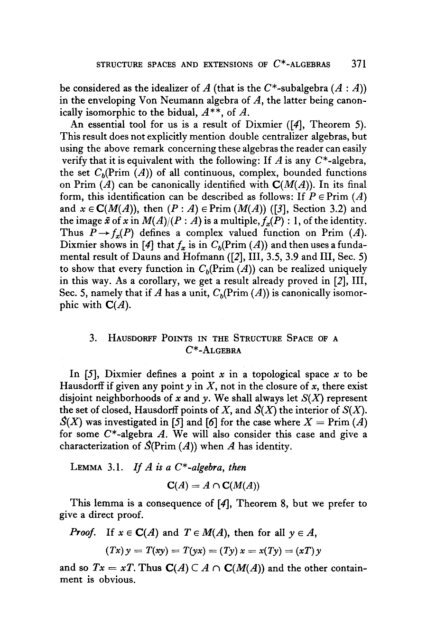On the Characters and the Plancherel Formula of Nilpotent Groups ...
On the Characters and the Plancherel Formula of Nilpotent Groups ...
On the Characters and the Plancherel Formula of Nilpotent Groups ...
You also want an ePaper? Increase the reach of your titles
YUMPU automatically turns print PDFs into web optimized ePapers that Google loves.
STRUCTURE SPACES AND EXTENSIONS 0~ C*-ALGEBRAS 371<br />
be considered as <strong>the</strong> idealizer <strong>of</strong> A (that is <strong>the</strong> C*-subalgebra (A : A))<br />
in <strong>the</strong> enveloping Von Neumann algebra <strong>of</strong> A, <strong>the</strong> latter being canonically<br />
isomorphic to <strong>the</strong> bidual, A**, <strong>of</strong> A.<br />
An essential tool for us is a result <strong>of</strong> Dixmier ([4], Theorem 5).<br />
This result does not explicitly mention double centralizer algebras, but<br />
using <strong>the</strong> above remark concerning <strong>the</strong>se algebras <strong>the</strong> reader can easily<br />
verify that it is equivalent with <strong>the</strong> following: If A is any C*-algebra,<br />
<strong>the</strong> set Cb(Prim (A)) <strong>of</strong> all continuous, complex, bounded functions<br />
on Prim (A) can be canonically identified with C(M(A)). In its final<br />
form, this identification can be described as follows: If P E Prim (A)<br />
<strong>and</strong> x E C(M(A)), <strong>the</strong>n (P : A) E Prim (M(A)) ([3], Section 3.2) <strong>and</strong><br />
<strong>the</strong> image R <strong>of</strong> x in M(A)/(P : A) is a multiple,f,(P) : 1, <strong>of</strong> <strong>the</strong> identity.<br />
Thus P+fJP) d e fi nes a complex valued function on Prim (A).<br />
Dixmier shows in [4] that fz is in C,(Prim (A)) <strong>and</strong> <strong>the</strong>n uses a fundamental<br />
result <strong>of</strong> Dauns <strong>and</strong> H<strong>of</strong>mann ([2], III, 3.5, 3.9 <strong>and</strong> III, Sec. 5)<br />
to show that every function in Cb(Prim (A)) can be realized uniquely<br />
in this way. As a corollary, we get a result already proved in [2], III,<br />
Sec. 5, namely that if A has a unit, C&Prim (A)) is canonically isomorphic<br />
with C(A).<br />
3. HAUSDORFF POINTS IN THE STRUCTURE SPACE OF A<br />
(?-ALGEBRA<br />
In [5], Dixmier defines a point x in a topological space x to be<br />
HausdorfI if given any pointy in X, not in <strong>the</strong> closure <strong>of</strong> x, <strong>the</strong>re exist<br />
disjoint neighborhoods <strong>of</strong> x <strong>and</strong> y. We shall always let S(X) represent<br />
<strong>the</strong> set <strong>of</strong> closed, HausdorfI points <strong>of</strong> X, <strong>and</strong> s(X) <strong>the</strong> interior <strong>of</strong> S(X).<br />
s(X) was investigated in [5] <strong>and</strong> [6] for <strong>the</strong> case where X = Prim (A)<br />
for some C*-algebra A. We will also consider this case <strong>and</strong> give a<br />
characterization <strong>of</strong> S(Prim (A)) when A has identity.<br />
LEMMA 3.1. If A is a C*-algebra, <strong>the</strong>n<br />
C(A) = A n C(M(A))<br />
This lemma is a consequence <strong>of</strong> [4], Theorem 8, but we prefer to<br />
give a direct pro<strong>of</strong>.<br />
Pro<strong>of</strong>. If x E C(A) <strong>and</strong> T E M(A), <strong>the</strong>n for all y E A,<br />
(Tx)y = T(q)= T(yx) =(Ty)x = x(Ty) =(xT)y<br />
<strong>and</strong> so TX = XT. Thus C(A) C A n C(M(A)) <strong>and</strong> <strong>the</strong> o<strong>the</strong>r contain-<br />
ment is obvious.

















